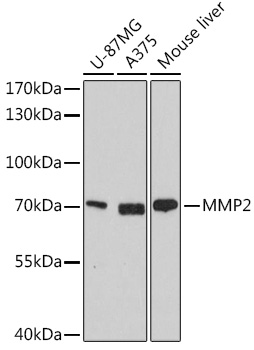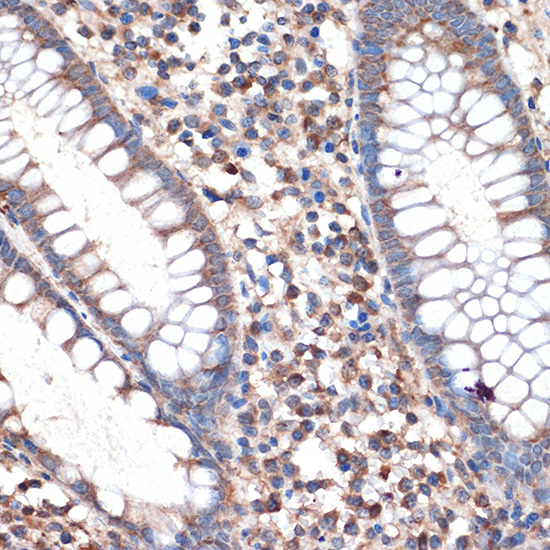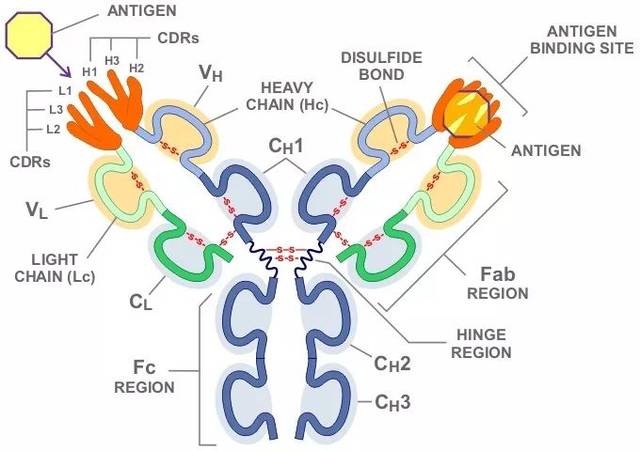Product Name :
MMP2 polyclonal antibody Background :
This gene is a member of the matrix metalloproteinase (MMP) gene family, that are zinc-dependent enzymes capable of cleaving components of the extracellular matrix and molecules involved in signal transduction. The protein encoded by this gene is a gelatinase A, type IV collagenase, that contains three fibronectin type II repeats in its catalytic site that allow binding of denatured type IV and V collagen and elastin. Unlike most MMP family members, activation of this protein can occur on the cell membrane. This enzyme can be activated extracellularly by proteases, or, intracellulary by its S-glutathiolation with no requirement for proteolytical removal of the pro-domain. This protein is thought to be involved in multiple pathways including roles in the nervous system, endometrial menstrual breakdown, regulation of vascularization, and metastasis. Mutations in this gene have been associated with Winchester syndrome and Nodulosis-Arthropathy-Osteolysis (NAO) syndrome. Alternative splicing results in multiple transcript variants encoding different isoforms. Product :
1mg/ml in PBS with 0.02% sodium azide, 50% glycerol, pH7.2 Storage&Stability :
Store at 4°C short term. Aliquot and store at -20°C long term. Avoid freeze-thaw cycles. Specificity :
Polyclonal Antibodies Immunogen :
Recombinant fusion protein of human MMP2(NP_004521.1). Conjugate :
Unconjugated Modification :
Unmodification
MMP2 polyclonal antibody Background :
This gene is a member of the matrix metalloproteinase (MMP) gene family, that are zinc-dependent enzymes capable of cleaving components of the extracellular matrix and molecules involved in signal transduction. The protein encoded by this gene is a gelatinase A, type IV collagenase, that contains three fibronectin type II repeats in its catalytic site that allow binding of denatured type IV and V collagen and elastin. Unlike most MMP family members, activation of this protein can occur on the cell membrane. This enzyme can be activated extracellularly by proteases, or, intracellulary by its S-glutathiolation with no requirement for proteolytical removal of the pro-domain. This protein is thought to be involved in multiple pathways including roles in the nervous system, endometrial menstrual breakdown, regulation of vascularization, and metastasis. Mutations in this gene have been associated with Winchester syndrome and Nodulosis-Arthropathy-Osteolysis (NAO) syndrome. Alternative splicing results in multiple transcript variants encoding different isoforms. Product :
1mg/ml in PBS with 0.02% sodium azide, 50% glycerol, pH7.2 Storage&Stability :
Store at 4°C short term. Aliquot and store at -20°C long term. Avoid freeze-thaw cycles. Specificity :
Polyclonal Antibodies Immunogen :
Recombinant fusion protein of human MMP2(NP_004521.1). Conjugate :
Unconjugated Modification :
Unmodification
-
 Western blot analysis of extracts of various cell lines, using MMP2 antibody at 1:1000 dilution.
Western blot analysis of extracts of various cell lines, using MMP2 antibody at 1:1000 dilution.
Secondary antibody: HRP Goat Anti-Rabbit IgG at 1:10000 dilution.
Lysates/proteins: 25ug per lane.
Blocking buffer: 3% nonfat dry milk in TBST.
Detection: ECL Basic Kit .
Exposure time: 10s. -
 Immunohistochemistry of paraffin-embedded mouse lung using MMP2 Rabbit pAb at dilution of 1:100 .Perform microwave antigen retrieval with 10 mM Tris/EDTA buffer pH 9.0 before commencing with IHC staining protocol.
Immunohistochemistry of paraffin-embedded mouse lung using MMP2 Rabbit pAb at dilution of 1:100 .Perform microwave antigen retrieval with 10 mM Tris/EDTA buffer pH 9.0 before commencing with IHC staining protocol. -
 Immunohistochemistry of paraffin-embedded mouse lung using MMP2 Rabbit pAb at dilution of 1:100 .Perform microwave antigen retrieval with 10 mM Tris/EDTA buffer pH 9.0 before commencing with IHC staining protocol.
Immunohistochemistry of paraffin-embedded mouse lung using MMP2 Rabbit pAb at dilution of 1:100 .Perform microwave antigen retrieval with 10 mM Tris/EDTA buffer pH 9.0 before commencing with IHC staining protocol. -
 Immunohistochemistry of paraffin-embedded mouse lung using MMP2 Rabbit pAb at dilution of 1:100 .Perform microwave antigen retrieval with 10 mM Tris/EDTA buffer pH 9.0 before commencing with IHC staining protocol.
Immunohistochemistry of paraffin-embedded mouse lung using MMP2 Rabbit pAb at dilution of 1:100 .Perform microwave antigen retrieval with 10 mM Tris/EDTA buffer pH 9.0 before commencing with IHC staining protocol.
Silencing NKD2 by Promoter Region Hypermethylation Promotes Esophageal Cancer Progression by Activating Wnt Signaling
PMCID: Pubmed No.:27374455
Lipoxin A4 Attenuates Cell Invasion by Inhibiting ROS/ERK/MMP Pathway in Pancreatic Cancer
PMCID: Pubmed No.:26649143
Suppression of motor protein KIF3C expression inhibits tumor growth and metastasis in breast cancer by inhibiting TGF-β signaling
PMCID: Pubmed No.:26272184
Fangchinoline targets PI3K and suppresses PI3K/AKT signaling pathway in SGC7901 cells
PMCID: Pubmed No.:25872479
Methylation of DIRAS1 promotes colorectal cancer progression and may serve as a marker for poor prognosis
PMCID: Pubmed No.:28491151
Neotuberostemonine attenuates bleomycin-induced pulmonary fibrosis by suppressing the recruitment and activation of macrophages
PMCID: Pubmed No.:27144994
Methylation of TMEM176A is an independent prognostic marker and is involved in human colorectal cancer development
PMCID: Pubmed No.:28678648
miR-958 inhibits Toll signaling and Drosomycin expression via direct targeting of Toll and Dif in Drosophila melanogaster
PMCID: Pubmed No.:27974298
IL-1β transcriptionally activates hepcidin by inducing C/EBPδ expression in hepatocytes
PMCID: Pubmed No.:28438835
IL-1β transcriptionally activates hepcidin by inducing C/EBPδ expression in hepatocytes
PMCID: Pubmed No.:28438835
Identification of Caspase-6 as a New Regulator of Alternatively Activated Macrophages
PMCID: Pubmed No.:27325699
Noscapine targets EGFR p-Tyr1068 to suppress the proliferation and invasion of MG63 cells
PMCID: Pubmed No.:27830833
Korean Byungkyul - Citrus platymamma Hort.et Tanaka flavonoids induces cell cycle arrest and apoptosis, regulating MMP protein expression in Hep3B hepatocellular carcinoma cells
PMCID: Pubmed No.:28035361
Apelin induces vascular smooth muscle cells migration via a PI3K/Akt/FoxO3a/MMP-2 pathway
PMCID: Pubmed No.:26494002
Downregulation of FOXP3 inhibits invasion and immune escape in cholangiocarcinoma
PMCID: Pubmed No.:25623530
Downregulation of FoxM1 inhibits proliferation, invasion and angiogenesis of HeLa cells in vitro and in vivo
PMCID: Pubmed No.:25201015
Intermittent bout exercise training down-regulates age-associated inflammation in skeletal muscles
PMCID: Pubmed No.:26545590
Fangchinoline as a kinase inhibitor targets FAK and suppresses FAK-mediated signaling pathway in A549
PMCID: Pubmed No.:25539072
(-)-β-hydrastine suppresses the proliferation and invasion of human lung adenocarcinoma cells by inhibiting PAK4 kinase activity
PMCID: Pubmed No.:26821251
Oxymatrine targets EGFRp-Tyr845 and inhibits EGFR-related signaling pathways to suppress the proliferation and invasion of gastric cancer cells
PMCID: Pubmed No.:25527205
Tetrandrine inhibits migration and invasion of rheumatoid arthritis fibroblast-like synoviocytes through down-regulating the expressions of Rac1, Cdc42, and RhoA GTPases and activation of the PI3K/Akt and JNK signaling pathways
PMCID: Pubmed No.:26614458
PPARγ regulates inflammatory reaction by inhibiting the MAPK/NF-κB pathway in C2C12 skeletal muscle cells
PMCID: Pubmed No.:27718123
Holothurian glycosaminoglycan inhibits metastasis via inhibition of P-selectin in B16F10 melanoma cells
PMCID: Pubmed No.:26318439
Evidence for a role of GPRC6A in prostate cancer metastasis based on case-control and in vitro analyses.
PMCID: Pubmed No.:27338047
Angiotensin II Induces an Increase in Matrix Metalloproteinase 2 Expression in Aortic Smooth Muscle Cells of Ascending Thoracic Aortic Aneurysms Through JNK, ERK1/2, and p38 MAPK Activation
PMCID: Pubmed No.:25955575
Epb41l3 suppresses esophageal squamous cell carcinoma invasion and inhibits MMP2 and MMP9 expression
PMCID: Pubmed No.:26916087
Knocking down Dp71 expression in A549 cells reduces its malignancy in vivo and in vitro
PMCID: Pubmed No.:26691328
Apocynin ameliorates pressure overload-induced cardiac remodeling by inhibiting oxidative stress and apoptosis.
PMCID: Pubmed No.:27782741
Changes in the expression of Col IV, gelatinase and TIMP-1 in oral leukoplakia
PMCID: Pubmed No.:31966707
Oxymatrine suppresses the growth and invasion of MG63 cells by up-regulating PTEN and promoting its nuclear translocation
PMCID: Pubmed No.:29029415
Tetraspanin-8 promotes hepatocellular carcinoma metastasis by increasing ADAM12m expression
PMCID: Pubmed No.:27270327
LncRNA-SVUGP2 suppresses progression of hepatocellular carcinoma
PMCID: Pubmed No.:29228655
UBE2T promotes nasopharyngeal carcinoma cell proliferation, invasion, and metastasis by activating the AKT/GSK3β/β-catenin pathway
PMCID: Pubmed No.:26943030
Overexpression of HMGB3 protein promotes cell proliferation, migration and is associated with poor prognosis in urinary bladder cancer patients
PMCID: Pubmed No.:25647262
Stromal-derived factor-1α/CXCL12-CXCR4 chemotactic pathway promotes perineural invasion in pancreatic cancer
PMCID: Pubmed No.:25605248
Epigenetic silencing of TMEM176A promotes esophageal squamous cell cancer development
PMCID: Pubmed No.:29050260
Silencing NKD2 by promoter region hypermethylation promotes gastric cancer invasion and metastasis by up-regulating SOX18 in human gastric cancer
PMCID: Pubmed No.:26396173
Different co-culture models reveal the pivotal role of TBBPA-promoted M2 macrophage polarization in the deterioration of endometrial cancer
PMCID: Pubmed No.:33609860
Methylation of NRN1 is a novel synthetic lethal marker of PI3K‐Akt‐mTOR and ATR inhibitors in esophageal cancer
PMCID: Pubmed No.:33931924
Long non-coding RNA MCM3AP-AS1 promotes growth and migration through modulating FOXK1 by sponging miR-138-5p in pancreatic cancer
PMCID: Pubmed No.:31830901
Circ_0088194 Promotes the Invasion and Migration of Rheumatoid Arthritis Fibroblast-Like Synoviocytes via the miR-766-3p/MMP2 Axis
PMCID: Pubmed No.:33692802
Circ_0088194 Promotes the Invasion and Migration of Rheumatoid Arthritis Fibroblast-Like Synoviocytes via the miR-766-3p/MMP2 Axis
PMCID: Pubmed No.:33692802
Caveolin-1 facilitates cell migration by upregulating nuclear receptor 4A2/retinoid X receptor α-mediated β-galactoside α2,6-sialyltransferase I expression in human hepatocarcinoma cells
PMCID: Pubmed No.:34157397
Epigenetic silencing of TMEM176A activates ERK signaling in human hepatocellular carcinoma
PMCID: Pubmed No.:30400968
Up-regulation of PTEN via LPS/AP-1/NF-κB pathway inhibits trophoblast invasion contributing to preeclampsia
PMCID: Pubmed No.:31896494
Long noncoding RNA NEAT1 promotes cell proliferation, migration, and invasion in hepatocellular carcinoma through interacting with miR‐384
PMCID: Pubmed No.:30346062
TMEFF2 inhibits pancreatic cancer cells proliferation, migration, and invasion by suppressing phosphorylation of the MAPK signaling pathway
PMCID: Pubmed No.:31920328
The Long Noncoding RNA LOXL1-AS1 Promotes the Proliferation, Migration, and Invasion in Hepatocellular Carcinoma
PMCID: Pubmed No.:33381389
Pectin Oligosaccharides Enhance α2,6-Sialylation Modification that Promotes Apoptosis of Bladder Cancer Cells by Targeting the Hedgehog Pathway
PMCID: Pubmed No.:34041669
Bioworld Biotech only provide peptides for our antibodies and do not provide additional peptide customization services.
Price/Size :
USD 368/1mg/vial
Tips:
For phospho antibody, we provide phospho peptide(0.5mg) and non-phospho peptide(0.5mg).Describe :
Blocking peptides are peptides that bind specifically to the target antibody and block antibody binding. These peptide usually contains the epitope recognized by the antibody. Antibodies bound to the blocking peptide no longer bind to the epitope on the target protein. This mechanism is useful when non-specific binding is an issue, for example, in Western blotting (WB) and Immunohistochemistry (IHC). By comparing the staining from the blocked antibody versus the antibody alone, one can see which staining is specific; Specific binding will be absent from the western blot or IHC performed with the neutralized antibody.Formula:
Synthetic peptide was lyophilized with 100% acetonitrile and is supplied as a powder. Reconstitute with 0.1 ml DI water for a final concentration of 10 mg/ml.The purity is >90%,tested by HPLC and MS.
Storage:
The freeze-dried powder is more stable. For short time at 2-8°C. For long term storage store at -20°C.
Note :
This product is for research use only (RUO only). Not for use in diagnostic or therapeutic procedures.
 MMP2 polyclonal antibody
MMP2 polyclonal antibody  Datasheet
Datasheet COA
COA MSDS
MSDS SHIP
SHIP